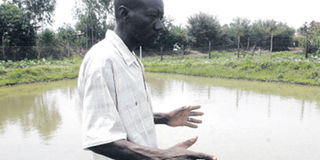What fish hatcheries don’t tell you can mess up your business

Amos Owiti in his fish farm in Kisumu County. PHOTO | TOM OTIENO | NATION MEDIA GROUP
What you need to know:
- The farmer had to start afresh, this time round buying fingerlings from a certified hatchery.
- Sandra Musangi of Athi Fish Farm and Hatchery in Machakos County says most hatcheries use chemicals to turn female fish into male.
- She warns that purchasing fingerlings from uncertified hatcheries leaves room for production errors that include wrong sizes, sexes and ratios of fish.
Standing at the edge of one of his ponds in Kisumu, Amos Owiti gazes at the fish as they dart in water making several ripples.
He had fed them an hour earlier and the catfish were seemingly exercising after enjoying the feeds.
“This time round I pray that they will not let me down. I have not earned from this project since I started it over a year ago.”
Owiti knows too well the frustration that follows a poor harvest. About a year ago, the farmer bought 3,000 tilapia fingerlings from a hatchery in the county at Sh5 each as he ventured into fish farming in a project that cost him Sh80,000.
The farmer had done his research well and knew that if he wanted best results, he should go for monosex fingerlings.
“I put 1,500 tilapia fingerlings I bought in the two ponds I had then. I was hopeful that I would get good harvest after about six months.”
After the period lapsed, Owiti realised the fish had not grown to the desired weight. Over 80 per cent of them failed to grow to full size and they were overpopulated in the pond.
Owiti sought advice from an agricultural officer and he was told that his fish was male and female.
“That is when I realised that I had been duped. What I was sold was not what I wanted. The fish reproduced putting pressure on the pond and I did not increase the quantity of feeds,” he explains.
In the event there’s reproduction, the increased population compete for food and oxygen. This leads to slow growth.
MATURE FASTER
“I sold the fish at a throw away price to traders to avoid incurring losses. I did not even make Sh10,000.”
The farmer had to start afresh, this time round buying fingerlings from a certified hatchery. “As a farmer, it is not easy to know that all the fingerlings one is buying are only male or female. You rely on the hatchery people who are in business and can sell you what you do not need.”
The experience has made Owiti to keep catfish only. “Catfish mature faster and fetch higher prices. They are also less likely to suffer stunted growth because they do not reproduce first,” the farmer says. Owiti has a plan on how to sell his fish in a region where tilapia is the king. “I will be frying them before selling directly to consumers. Fresh catfish has low demand.”
Sandra Musangi of Athi Fish Farm and Hatchery in Machakos County says most hatcheries use chemicals to turn female fish into male.
“Sex reversal is never 100 per cent foolproof. Sometimes it backfires and you end up with both male and female fish. Chances of this happening are 40 per cent. Introduction of catfish may not help when the fish is mature. Overpopulation of the pond results in stunted growth. A farmer should thus keep both tilapia and catfish from the start,” she explains as she adds some of Owiti’s fish might have reverted to female.
She advises that hatcheries should explain to farmers that the fingerlings they sell are a result of reversal and then educate them on how to manage the ponds to curb losses.
She notes that pond management is a crucial determiner of success for any fish species.
“It ranges from correct size and design of the pond to suit various fish species, right water levels, feeding and sampling at maturity.”
She warns that purchasing fingerlings from uncertified hatcheries leaves room for production errors that include wrong sizes, sexes and ratios of fish.




